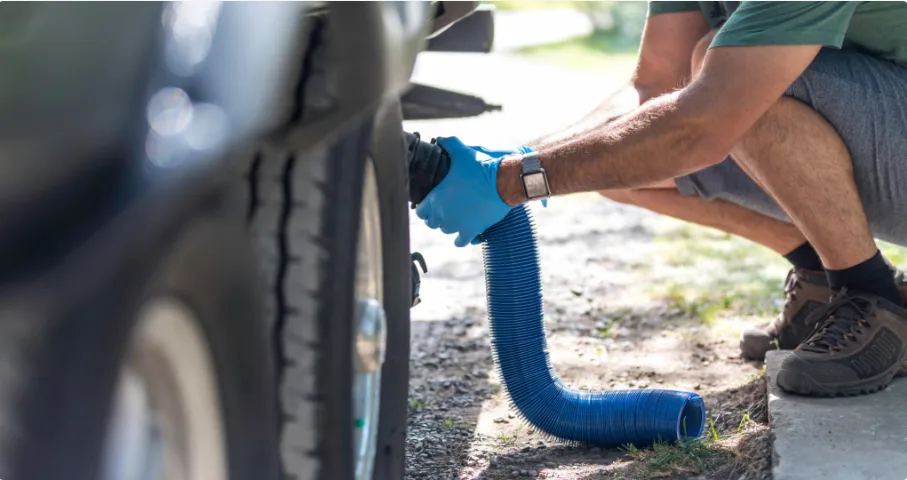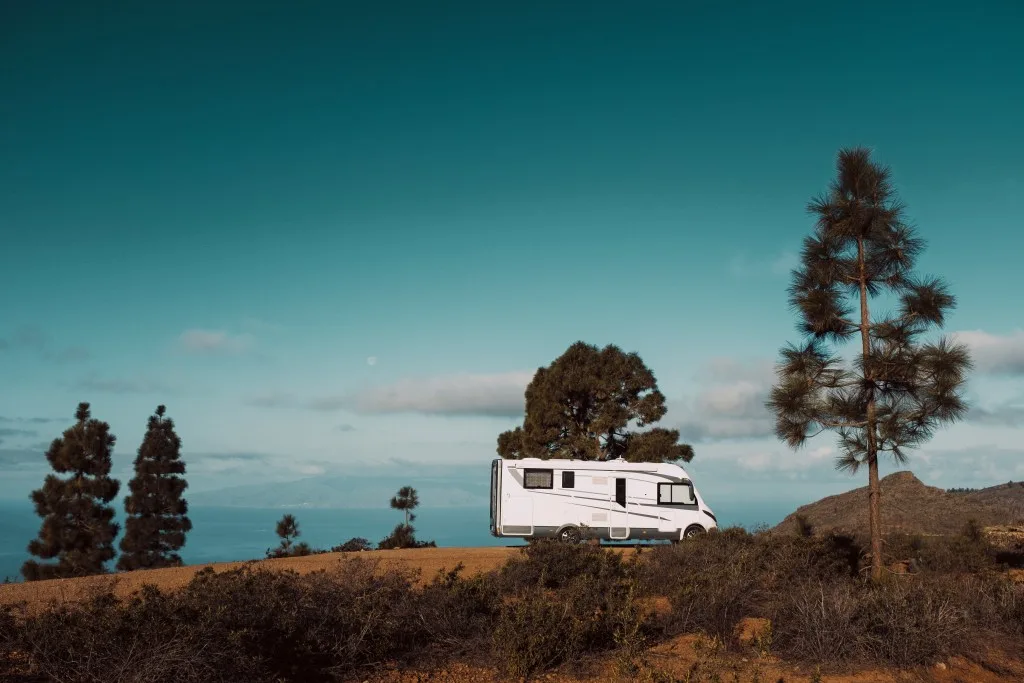Dumping your RV tanks can be a nasty job, but somebody has to do it. Of all the tasks RVers must do, dumping RV tanks is one of the least favorite for many RVers. Make the job as sanitary as possible and avoid getting any liquids (or solids) from getting on you or the ground.
Some RVers take extra safety precautions and wear gloves when dumping their RV tanks. Should you?
Today, we’ll answer this question and walk you through how to dump your tanks to avoid a “poopsie.” Let’s get started!
What Are RV Tanks?
Most RVs have different tanks for storing fluids. Freshwater tanks store clean water. This is potable water that an RVer uses for cooking, cleaning, and drinking.
Those RVers who spend most of their time in RV parks or campgrounds may use this tank sparingly. However, it benefits those who want to camp in spots without a water connection or boondock in remote areas.
In addition, it’s common to find black and gray tanks on RVs. These tanks do similar jobs but store different types of liquids.
The gray tank stores anything that goes down a shower or sink drain. This includes soapy water from showering, washing hands, and doing dishes. Many RVers underestimate the potential grossness of this tank. When soapy water mixes with oils from your skin and food remnants from dishes, it can get gross.
The final type of RV tank is a black tank. These tanks typically sit directly beneath toilets in an RV and store any solids or liquids that get flushed down the toilet.
As a result of the contents, this is the tank that many RVers fear the most when emptying their tanks. However, we’ll walk you through properly dumping your RV tanks.

How Do You Properly Dump RV Tanks?
Properly dumping your RV tanks requires that you take your time. You’re more likely to make a mistake or skip an important step when in a hurry. Even if it’s check-out time at the campground and you have a long line at the dump station, do your best to avoid feeling rushed.
After pulling up to a dump station, gather the necessary supplies. This will include a sewer hose and any attachments you’ll need to connect it to your RV and the sewer connection.
Before connecting your sewer hose to your RV, close the dump valves. If not shut, you’ll have a messy situation when you remove the sewer cap.
Next, connect the appropriate attachments to the hose and the sewer connection. Use a rock, brick, or another heavy object to keep the sewer hose connected to the dump station.
Now, remove the sewer cap and connect the sewer hose to your RV. We recommend placing the sewer hose directly underneath the drain as you slowly release the cap to catch any liquids in the pipe.
With everything connected, drain the black tank first and then the gray tank. This allows you to flush out any sewage or other materials that might stick to the inside of your sewer hose. Give the tanks plenty of time to empty so you get as much as you can out of them.
If you have a black tank flush, you can connect a hose and fill your black tank with water and empty it again. This helps keep your black tank and the tank sensors as clean as possible.
When complete, pack up all of your things and store them appropriately. Use the water source to clean up any messes or liquids that may have found their way onto the ground during the process.
Always leave a dump station cleaner than you found it.
Pro Tip: Diving with a full black tank is not always a great idea. Find out why.
Should You Wear Gloves When Dumping RV Tanks?
No matter how careful you are when dumping your RV tanks, drippage will occur. The contents of your RV tanks can contain harmful bacteria that you want to avoid getting on you as much as possible. Wearing gloves is a great way to avoid coming in contact with bacteria that could cause health issues.
We recommend keeping a box of disposable rubber gloves with your dump station gear. Always put on your gloves before touching any items you’ll need to dump your tanks. You want to avoid contact with the bacteria as much as possible.
If you RV regularly, you can go through a ton of rubber gloves. Many full-time RVers end up using reusable rubber gloves. These thick gloves are easy to clean and only get used when dumping tanks.
When dumping your tanks, no matter what type of glove you wear, be aware of what you touch. We’ve seen far too many RVers using their phones, scratching their faces, and getting in and out of their vehicle while wearing gloves and dumping their tanks.
In these situations, you’re simply spreading the bacteria to other surfaces you’ll touch later when you’re not wearing gloves.

Which RV Tank Do You Empty First?
The order in which you dump your tanks is important because it can help clean your sewer hose and attachments. Start dumping your black tank and then move to your gray tank.
By emptying your RV tanks in this order, you decrease the chances of solids sticking to the inside of your sewer hose or attachments.
When finished, thoroughly rinse your sewer hose and any attachments. The last thing you want to do is to store your supplies and gear with waste sitting in them. If you don’t, you could be in for a surprise the next time you need to use them.
How Long Can Black Water Stay in an RV Tank?
There’s no set time that black water can stay in an RV tank. However, the longer black water sits in your tank, the more likely you will experience odors.
Dump your tanks at the end of every trip, especially if you have a week or more between uses. If not, you could return to your RV and discover it’s filled with a horrific odor the next time you use it.
Ideally, you want your tanks to be at least two-thirds full when you dump them. The force of gravity pushing the liquids out helps ensure any solids leave the tank.

Should You Leave Your Black Tank Empty?
Avoid leaving your black tank empty unless you need to winterize your RV at the end of the season. Keeping a few gallons of water in the bottom can minimize the chances of any solids left in the bottom of your tank continuing to solidify. Over time these solids can become incredibly hard and could cause clogs or other issues when dumping.
We recommend dumping your tanks, adding several gallons of water, and using an enzyme tank treatment to break down any bacteria or other substances in your black tank. This can help reduce odors and keep your black tank clean.
How Do I Sanitize My RV Black Tank?
Many modern RVs come with a black tank flush. These make cleaning your RV black tank very easy. We recommend using a designated water hose to connect a water source to your flush connection.
After securing the hose to your black tank flush, turn the water source on and let the flush do its job. Water will travel through the hose and a water line in the plumbing system to a spray nozzle inside the black tank.
This will spray water inside the tank and help remove any solids sticking inside. Fill up the tank, but don’t overfill it.
Once the tank is full, you can open the black tank dump valve and dump the water into the sewer connection. You’ll want to repeat this process a few times or until you see clear water with no solids leaving your tank.
After flushing your system, fill the black tank with several gallons of water and use a tank treatment. Regularly using a tank treatment can help reduce bacterial growth and promote the growth of enzymes that eat away at the odor-causing bacteria.
It also helps break down the solids in your black tank, which minimizes clogs and ensures a smooth experience at the dump station.
Pro Tip: Sanitizing your RV tanks? We uncovered Is It Safe to Put Bleach in Your RV Black Tank?
Do Wearing Gloves When Dumping RV Tanks Protect You?
Wearing gloves when dumping your RV tanks can protect you when used correctly. However, far too many RVers think they protect themselves by wearing gloves but then risk spreading bacteria by touching other surfaces while wearing gloves and emptying their tanks.
Gloves do protect you. But still, watch what you touch while dumping your tanks, and always use plenty of hand sanitizer when finished.
Discover the Best Free Camping Across the USA
To be honest with you, we hate paying for camping. There are so many free campsites in America (with complete privacy).
You should give it a try!
As a matter of fact, these free campsites are yours. Every time you pay federal taxes, you’re contributing to these lands.
Become a FREE CAMPING INSIDER and join the 100,000 campers that love to score the best site!
We’ll send you the 50 Best Free Campsites in the USA (one per state). Access the list by submitting your email below: